



I hope that you have already begun to experiment with Popular Rock Beat Variations like those on Lesson #12 , Lesson Menu #1.
There are 4.3 billion potential permutations or variations of 8th-note 4/4 Rock. When we use the street term 'Fatback', we might be referring to any of those patterns. This means that the term 'Fatback' is a fairly broad description for a lot of (similar sounding) rhythms.
FATBACK (definition)?
Fatback is only a street term, but it is the most common
on-stage-term being used for these 'largely unnamed' rhythm patterns. The drumming term
or song-beat term, 'Fatback' hasn't made it into the music dictionaries, (yet).
The term was coined sometime in the mid-1960's, obviously by
some of the older musicians of that era. The term caught-on,
and is now used very often on the bandstands around the world, today.
No one seems to know who coined the term.
The drumming term 'Fatback' has become the popular label among rock, blues, jazz and soul musicians to describe a whole series of 8th-note 4/4 rock beat (or song-beat) variations, and syncopations. The label 'Fatback' may have stuck, as a way of saying that the BACKbeat, is unusually 'loud' or 'FAT'. In other words, we could say that Fatback is a rhythm with an unusually loud, strong or . . . 'FAT', 'BACK-BEAT and it also may or may not include lighter (or softer) snare and bass drum variations and/or syncopations.
NOTE: The terms 'Funk' and 'Funky' are both used often when referring to these same (potential) 4.3 billion permutations of 16th, 8th and 4th rock permutations.
If we do a chronological study of Pop, Rock, Soul, Funk and Jazz music, it is interesting to note that since about 1965; four specific 'Fatback' rhythms have predominated all those music styles, and they still do today. Therefore, if a student drummer has mastered those 4 popular patterns (shown below), it will set them on their way towards easily and automatically playing nearly any of the other (similar) rhythm patterns that may emerge within those same song-beat frameworks.
It has been about the same way every year since the mid 1960s to the current time. This same handful of 8th rock (song beat) permutations will most likely tend to continually predominate all pop music styles, from rock to jazz, and even C&W music styles for many years to come. Fatback tends to be the root rhythm of a very high percentage (25% to 30%) of all popular-music styles.
We drummers need to master the four most popular variations of those Fatback patterns. Though there are technically more than 4.3 billion options, (which is a bit daunting); but it's a lot easier than that. You'll learn the bulk of these rhythmic variations in a natural way . . . as needed within the music, as you jam. The secret to accelerating the learning curve is to completely master the following 4 patterns in this lesson, then listen for them in the music you'll hear playing around you every day.
I will show you the four most popular 8th-note 4/4 'Fatback' rhythms, here in this lesson. For simplicity, I will take the liberty to label them Fatback #1, #2, #3 and #4 as a way to reference them.
You should try to memorize all four of these beats. You will hear them over & over again in nearly any music styles you may favor.
FATBACK #1: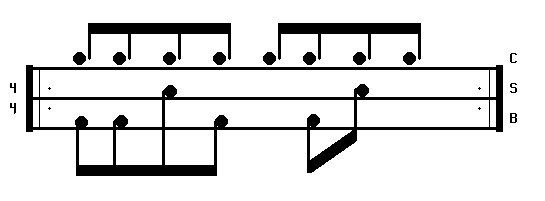
![]() Listen to it. This is the Fatback pattern we learned in Lesson #12.
Listen to it. This is the Fatback pattern we learned in Lesson #12.
Video: For almost all handheld devices and other browsers.
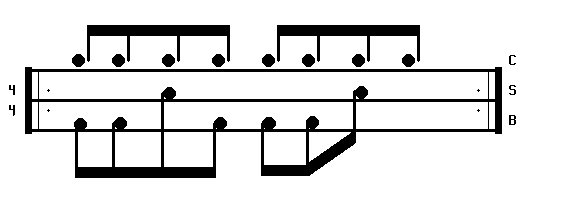
![]() Listen to it and learn it. You will be needing it.
Listen to it and learn it. You will be needing it.
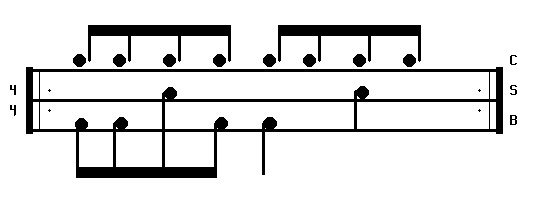
Video: For almost all handheld devices and other browsers.
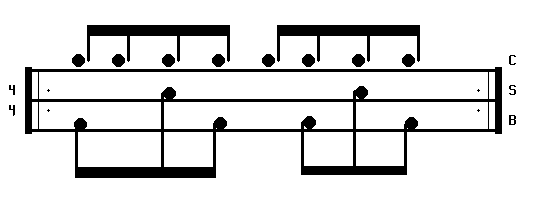
![]() This one sounds much different than it looks! Listening to the sound file will make it easier.
This one sounds much different than it looks! Listening to the sound file will make it easier.
After learning these 'simple' Fatback (aka; 'Funk') patterns above, you should learn a little about adding SNARE SYNCOPATIONS to 8th-note Rock and Fatback, in the following, Lesson #93 on Lesson Menu #1.
You are currently learning some of the most difficult maneuvers in drumming. I can promise that your effort will not go unrewarded. Once you master snare syncs and bass syncs with Fatback, your playing ability will grow by leaps and bounds. This is where you will learn to play all the really neat 'funky' beat patterns.
After gaining control with these concepts, your imagination will begin to take over. Hopefully, within a few weeks of diligent effort, hundreds of new beat patterns should begin to occur as if by magic. Much depends on the amount of effort expended, and also how closely you listen to the recorded drummers within your favorite music. I am not particularly fond of 'Rap' music, but both Rap and Hip-Hop are often riddled with syncs like the ones we are touching on here.
I will step up the pace a little below. If it seems impossible to do this stuff . . . the fault will be mine. Don't blame yourself! It's VERY COMMON for even the best students to encounter difficulties with this material below. Think in terms of weeks and months, rather than hours and days, as you learn all this. It takes time to gain the (limb coordination) expertise that will arrive as a result of this knowledge.
Remember, I haven't heard you play. It may happen that the pace I'm setting here may be too fast. Slow down, jam, have fun, and be patient. These techniques will evolve slowly as you listen, jam, and learn.
Bass syncs may be used in any of the dance beat categories, but the best (most interesting) tend to occur within the 8th-note 4/4 rock beat. Then, as you master and learn them here it will become intuitive to add them to all the other song-beat structures.
SYNCOPATION (definition):
Look up the word syncopation in the dictionary. It gives a
pretty broad description of the term. For our purposes, (from
the drummers perspective) . . . a syncopation is when we play a
snare or bass note "in-between" any of the steady cymbal notes.
BASS SYNCOPATIONS:
Example A:
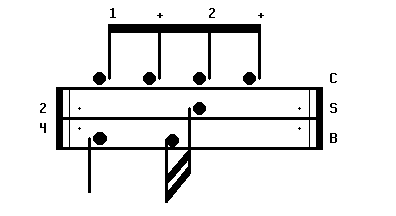
Video: For almost all handheld devices and other browsers.
The second bass drum in the above example is 'between the cymbals' or syncopated. Your right hand will naturally want to hit with that 2nd bass. Do not allow it. Fight to separate the bass from the right hand. This is the beginning of some very complex and popular rock patterns. If it is too easy then move ahead. If it seems totally impossible, move to the second part of this lesson for easier ways to approach the concept.
Example B.
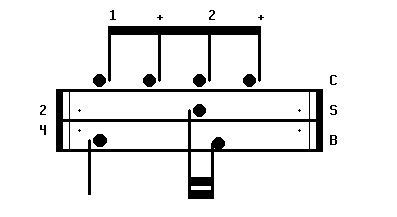
![]() Similar beat but with a twist.
Similar beat but with a twist.
Video: For almost all handheld devices and other browsers.
Remember, these are repeating patterns! The cymbal line will remain constant throughout the entire procedure as you play the beats over and over.
Example C.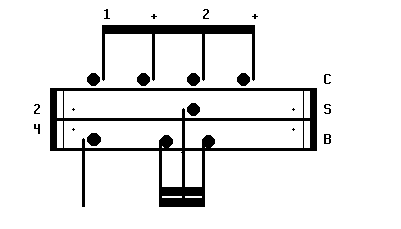
![]() VIDEO: Click here to 'Play', see, and hear the above Bass Sync, Example C., video. (For use with IE and Win Media Player.)
VIDEO: Click here to 'Play', see, and hear the above Bass Sync, Example C., video. (For use with IE and Win Media Player.)
Video: For almost all handheld devices and other browsers.
These patterns are much easier when you can hear the way they should sound. Just trust the ol' teacher on this one. If these patterns are new and difficult, then maybe I have hit the mark. Just keep trying until you are certain they are impossible, heheh. (Section 2 of this lesson is designed to develop more gradually, if that IS the case).
Bass Syncs are EXTREMELY valuable and well worth the effort required. You will climb to new levels of ability in a very short time once these and a few other similar patterns have been mastered.
As extra practice, try injecting these patterns randomly into a basic rock beat in progress . . . then into your favorite (slower rock) music. After studying and memorizing these ideas, you will be amazed to discover how often they turn up in the very songs you have been practicing with all along. I am predicting that these are the beats that may have caused you some self-doubt in the past.
The objective is to teach the foot to do one thing while the right hand does something else. Some call it limb-independence.
You will need to study these patterns at a snails pace in the beginning. Your speed will increase as you gradually gain control and develop special coordination with your foot.
An interesting bit of good news. As you gain control with rock syncs, you will find that it is easy to transfer these same general techniques to the blues beat and all other dance beat patterns.
BASS SYNC EXERCISES:
The two exercises that follow should develop your foot even further.
These two patterns appear very simple at first glance. Don't let that
fool you. it may take several weeks to push them to maximum speed.
They are extremely important! Many of the hottest rock beats will be made
up of these two patterns. Start very S L O W L Y and build speed over
several hours of persistent practice.
EXERCISE #1:
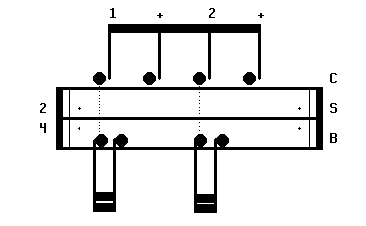
![]() The faster you can play this, the sooner you will reach new plateaus.
The faster you can play this, the sooner you will reach new plateaus.
Video: For almost all handheld devices and other browsers.
The first bass is with the cymbal . . . the second bass is very quick but between the cymbal notes. The cymbal is constant and there is no snare note in these two exercises.
EXERCISE #2:
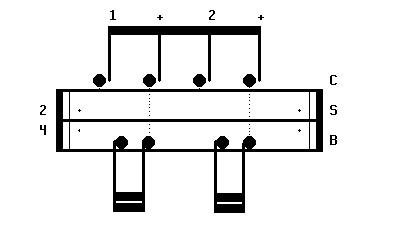
![]() Listen, memorize . . . then repeat, repeat, repeat.
Listen, memorize . . . then repeat, repeat, repeat.
![]() VIDEO: Click here to 'Play', see, and hear the above Fatback variation, video. (Use IE with Win Media Player.)
VIDEO: Click here to 'Play', see, and hear the above Fatback variation, video. (Use IE with Win Media Player.)
Video: For almost all handheld devices and other browsers.
In the above pattern the syncopated bass is falling before the cymbal while the second bass is with the cymbal.
Syncopated Beat: This beat uses everything we have learned so far . . .
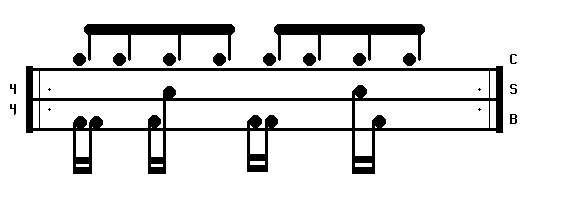
Video: For almost all handheld devices and other browsers.
EXTRA PRACTICE: This will become your favorite beat, if you have the stamina to master it!
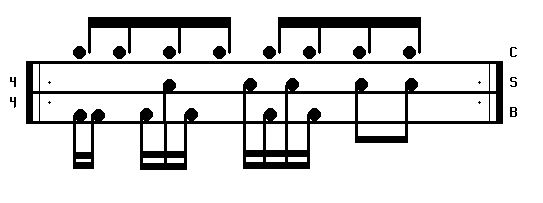
Video: For almost all handheld devices and other browsers.
Of course, any fill or roll pattern may be used with the above techniques. To learn more about adapting fills to the 8th-note Rock beats, see the following lessons:
Rudiments, Rolls & Fills: Part I
Rudiments, Rolls & Fills: Part II
![]() Drum Solo Video: Click to 'LEARN'
Drum Solo Video: Click to 'LEARN'
Watch and Learn Now! PLAY Great Drum Solos within hours (not years).
NEW 'Subliminal Method' teaches drum solo techniques PAINLESSLY!
Master rudiments 'NATURALLY' without boring regimentation or serious discipline.
Listen, watch and PLAY your way to awesome drum solos (and polished rudiments) BY SIMPLY HAVING FUN. . . . It works, folks!
Don't be a skeptic until you at least try it first.
![]()
![]()
7 EZ lessons to Rhythm-Guru Status.
E-mail support: (til I croak).
EZ Downloads to CDs/Flashdrives
Special Secret Seeds of Rhythm.
Breaking-into Career Drumming $$
Musical Time - Finite to Infinity: Learn to easily jam and play music comfortably within any odd or even time signature. This material isn't currently taught in music-theory classes, yet it is simple enough for grade-school students. Discover more than 18 quintillion unique and different (modern music) song-beat structures.
Discover the (lost) 500 year-old enigmatic secrets hidden within the current time-signature system. Seven short mesmerizing and easy-to-follow lessons will lead you quickly and easily towards (musical-time) guru status. You will learn to visualize (read, write or feel) the existence More . . .
This very informative little booklet will amaze you with hundreds of valuable tips and insider secrets!
HOW TO: Purchase old/used drumsets for pennies and resell them for decent profits. How to find the bargains, create thousands of attention getting finishes at low cost. Brighten old cymbals and learn to rebuild old drumsets from the gound up.